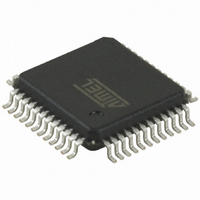AT32UC3B1128-AUT Atmel, AT32UC3B1128-AUT Datasheet - Page 175

AT32UC3B1128-AUT
Manufacturer Part Number
AT32UC3B1128-AUT
Description
IC MCU AVR32 128KB FLASH 48-TQFP
Manufacturer
Atmel
Series
AVR®32 UC3r
Specifications of AT32UC3B1128-AUT
Core Processor
AVR
Core Size
32-Bit
Speed
60MHz
Connectivity
I²C, IrDA, SPI, SSC, UART/USART, USB
Peripherals
Brown-out Detect/Reset, DMA, POR, PWM, WDT
Number Of I /o
28
Program Memory Size
128KB (128K x 8)
Program Memory Type
FLASH
Ram Size
32K x 8
Voltage - Supply (vcc/vdd)
1.65 V ~ 1.95 V
Data Converters
A/D 6x10b
Oscillator Type
Internal
Operating Temperature
-40°C ~ 85°C
Package / Case
48-TQFP, 48-VQFP
Package
48TQFP
Device Core
AVR32
Family Name
AT32
Maximum Speed
60 MHz
Operating Supply Voltage
1.8|3.3 V
Data Bus Width
32 Bit
Number Of Programmable I/os
28
Interface Type
I2S/SPI/TWI/USART/USB
On-chip Adc
6-chx10-bit
Number Of Timers
3
For Use With
ATSTK600-TQFP48 - STK600 SOCKET/ADAPTER 48-TQFPATAVRONEKIT - KIT AVR/AVR32 DEBUGGER/PROGRMMR770-1008 - ISP 4PORT ATMEL AVR32 MCU SPIATEVK1101 - KIT DEV/EVAL FOR AVR32 AT32UC3B
Lead Free Status / RoHS Status
Lead free / RoHS Compliant
Eeprom Size
-
Available stocks
Company
Part Number
Manufacturer
Quantity
Price
- Current page: 175 of 692
- Download datasheet (11Mb)
17.5.3
17.5.4
32059K–03/2011
Interrupts
Interrupt Timings
The GPIO can be configured to generate an interrupt when it detects an input change on an I/O
line. The module can be configured to signal an interrupt whenever a pin changes value or only
to trigger on rising edges or falling edges. Interrupts are enabled on a pin by writing a one to the
corresponding bit in the Interrupt Enable Register (IER). The interrupt mode is set by writing to
the Interrupt Mode Register 0 (IMR0) and the Interrupt Mode Register 1(IMR1). Interrupts can be
enabled on a pin, regardless of the configuration of the I/O line, i.e. whether it is controlled by the
GPIO or assigned to a peripheral function.
In every port there are four interrupt lines connected to the interrupt controller. Groups of eight
interrupts in the port are ORed together to form an interrupt line.
When an interrupt event is detected on an I/O line, and the corresponding bit in IER is written to
one, the GPIO interrupt request line is asserted. A number of interrupt signals are ORed-wired
together to generate a single interrupt signal to the interrupt controller.
The Interrupt Flag Register (IFR) can by read to determine which pin(s) caused the interrupt.
The interrupt bit must be cleared by writing a one to the Interrupt Flag Clear Register (IFRC). To
take effect, the clear operation must be performed when the interrupt line is enabled in IER. Oth-
erwise, it will be ignored.
GPIO interrupts can only be triggered when the CLK_GPIO is enabled.
The figure below shows the timing for rising edge (or pin-change) interrupts when the glitch filter
is disabled. For the pulse to be registered, it must be sampled at the rising edge of the clock. In
this example, this is not the case for the first pulse. The second pulse is however sampled on a
rising edge and will trigger an interrupt request.
Figure 17-4. Interrupt Timing With Glitch Filter Disabled
The figure below shows the timing for rising edge (or pin-change) interrupts when the glitch filter
is enabled. For the pulse to be registered, it must be sampled on two subsequent rising edges.
In the example, the first pulse is rejected while the second pulse is accepted and causes an
interrupt request.
Figure 17-5. Interrupt Timing With Glitch Filter Enabled
GPIO_IFR
GPIO_IFR
Pin Level
Pin Level
clock
clock
AT32UC3B
175
Related parts for AT32UC3B1128-AUT
Image
Part Number
Description
Manufacturer
Datasheet
Request
R

Part Number:
Description:
DEV KIT FOR AVR/AVR32
Manufacturer:
Atmel
Datasheet:

Part Number:
Description:
INTERVAL AND WIPE/WASH WIPER CONTROL IC WITH DELAY
Manufacturer:
ATMEL Corporation
Datasheet:

Part Number:
Description:
Low-Voltage Voice-Switched IC for Hands-Free Operation
Manufacturer:
ATMEL Corporation
Datasheet:

Part Number:
Description:
MONOLITHIC INTEGRATED FEATUREPHONE CIRCUIT
Manufacturer:
ATMEL Corporation
Datasheet:

Part Number:
Description:
AM-FM Receiver IC U4255BM-M
Manufacturer:
ATMEL Corporation
Datasheet:

Part Number:
Description:
Monolithic Integrated Feature Phone Circuit
Manufacturer:
ATMEL Corporation
Datasheet:

Part Number:
Description:
Multistandard Video-IF and Quasi Parallel Sound Processing
Manufacturer:
ATMEL Corporation
Datasheet:

Part Number:
Description:
High-performance EE PLD
Manufacturer:
ATMEL Corporation
Datasheet:

Part Number:
Description:
8-bit Flash Microcontroller
Manufacturer:
ATMEL Corporation
Datasheet:

Part Number:
Description:
2-Wire Serial EEPROM
Manufacturer:
ATMEL Corporation
Datasheet:











